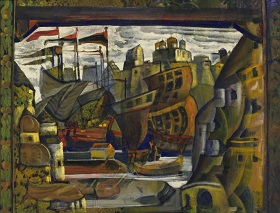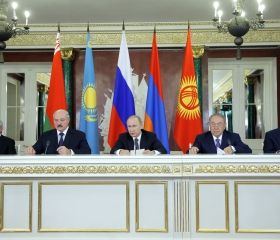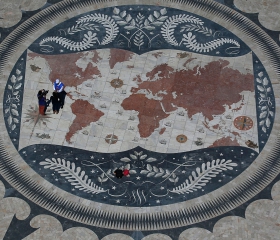Goodbye Post-Soviet Space?
Workers prepare Soviet-time statues for dismantling
in Vilnius, Lithuania, July 20, 2015
In
Login if you are already registered
(votes: 3, rating: 4.67) |
(3 votes) |
Ph.D in History, Leading Research Fellow at MGIMO University, Editor-in-Chief of International Analytics Magazine
More than two decades after the collapse of the USSR, the phrase “the post-Soviet space” is still widely used in expert and political discourse, despite attempts to replace it with another definition” such as the “Newly Independent States” or “Eurasia”.
More than two decades after the collapse of the USSR, the phrase “the post-Soviet space” is still widely used in expert and political discourse, despite attempts to replace it with another definition” [1] such as the “Newly Independent States” or “Eurasia”.
At first glance, the concept of the “post-Soviet space” is firmly tied to the idea of a state of transition. It records a reality that emerged after the disintegration of what was once a unified state. However, during the time since the collapse of the USSR, that reality has changed dramatically and continues to change before our eyes. After all, the definition “post-British space” was never used with regard to India, Pakistan, Bangladesh or Nigeria. Similarly, Indochina and Algeria were never referred to as “post-French”.
Fifteen independent states appeared on the world map with the collapse of the USSR. Each of these states has covered an arduous path of national construction and gaining international legitimacy. In the intervening period, the space that had been the Soviet Union until 1991 has become greatly fragmented. Some former Soviet republics have joined NATO and the European Union, while others are trying to form an alternative to the Euro-Atlantic project in the shape of Eurasian integration.
The breakup of the USSR did not exactly follow the borders formed during the Soviet period. Many new independent states, including Russia, have faced challenges in the form of separatists and lived through ethno-political conflicts. As a result, de facto entities emerged that have received only partial international recognition or no recognition at all. Russia went through the complicated and controversial process of integrating an unrecognized republic that had been outside the jurisdiction of the central government for six years.
Whatever the case, the initial conditions of the disintegration of what was once a unified state as formulated in the Belavezha Accords and the Declaration of Alma-Ata was in 1991 no longer reflect reality. [2] The principle of the inviolability of the borders between republics has been contravened on a number of occasions. Precedents have been set whereby the independence the former union states, as well as of autonomous entities, is recognized, as are changes in the jurisdiction of the territory of one country in favour of another.
The new state entities have complicated and often openly hostile relations with one another, and most of all with the centre of former military, economic and political power, which is now embodied by the Russian Federation as the legal successor to the USSR. Of the 15 former republics of the Soviet Union, four have no diplomatic relations with one another (Armenia and Azerbaijan, Russia and Georgia). Unregulated border disputes are the bane of practically all Central Asian states. Russia and Ukraine have not broken diplomatic relations formally, but relations between the two countries are at their lowest ebb since December 1991.
The new independent states are more integrated into the world economy and politics. Important international players such as the United States, the European Union (and individual European countries), the People’s Republic of China, Japan, Turkey, Iran, integration structures (NATO) and transnational corporations have indicated that they have interests in the former USSR. Their presence is prompted not only by the aspirations of these players themselves; the new national elites in these states also have reasons to welcome the participation of external forces. As a consequence, the territory of what was once a single state becomes an area of rivalries.
The common historical past that once linked the peoples of the USSR has ceased to be a uniting factor. On the contrary, as events in Ukraine, Moldova and Transcaucasia have shown, this past is becoming an object of heated debate and “memory wars”, which are by no means always confined to academic and journalistic formats.
The question may well be asked: How much longer will it be relevant to speak about states with different identities, models of state building, foreign policy interests and values as single entities bound by the borders of the post-Soviet space and the structured community based on that definition? There are no prerequisites for the recreation of what used to be a unified state, not to speak of the fact that such a hypothetical entity cannot be based on a Soviet economic, political and ideological platform. Would it not be easier to dump the concept as no longer reflecting modern realities?
The Soviet and the Post-Soviet: An Inseparable Link

Ivan Timofeev, Elena Alekseenkova:
Eurasian Geo-Economics: A View from Russia
The above questions are not as simple and straightforward as they may first appear. To begin with, in spite of the considerable fragmentation of what used to be a common space and the sharp conflicts within it, it still has links with its Soviet past, whether this pleases consistent champions of the ideals of decommunization or not. In other words, the concept of the “post-Soviet space” cannot be separated from the Soviet context.
Indeed, in December 1991, a state that occupied one-sixth of the earth’s surface disappeared from the world map. The disintegration of the USSR has been completed in formal legal terms. But, historically, the process of disintegration has only just begun, because it triggered the formation of new state entities and political nations, a process that still continues. This much is clear from the unsettled conflicts in Donbass, Transnistria and Nagorno-Karabakh, and parallel political and legal situations in Abkhazia, South Ossetia and Crimea. Russia has recognized the independence of the former autonomies, which Georgia and a number of Western countries consider to be occupation. As far as Russia is concerned, Crimea and Sevastopol are two constituent entities of the Russian Federation, while Ukraine and its Western partners see them as annexed Ukrainian territories.
The question is not solely or largely about the interference of Moscow, Washington or Brussels, but of the inability of the new state elites to pursue national construction without conflicts and in the interests of various ethnic groups and regions. Meanwhile, in spite of publicly professing a clean break with the past, they are still caught up in Soviet approaches and models.
The main subjects in the USSR were not citizens, but rather socialist nations. In fact, the Soviet state identified ethnic groups as the key subjects of politics and state law. The priorities were the rights of nations and not of individuals. Ethnic differences between Soviet citizens were sealed in territorial terms. The number of ethnic groups entitled to their “own land” varied depending on the twists and turns of the Party’s general line.

Sergey Rekeda:
Coexistence Instead of Integration
Eurasia Comes Apart into Economic Blocks
In practice, this created the perception of collective (ethnic) property of this or that ethnic entity (in its highest phase, national entity) of a territory designated as a national republic, an autonomy within a national republic and even ethnically constructed areas. Renunciation of individual rights in favour of collective rights created the prerequisites for the emergence of ethno-national movements for self-determination of future independent states and the emergence of hotbeds of conflict and unrecognized republics. As Russian-born American ethnologist Yuri Slezkine aptly put it, the USSR was created by nationalists, and it was destroyed by nationalists [3]. As early as 1924, the prominent Lithuanian Bolshevik Juozas Vareikis came up with a brilliant formula to describe the USSR, calling “the world’s first state of workers and peasants” a communal apartment that has been rebuilt repeatedly through administrative and territorial transformations (and often the deportation of entire peoples) [4].
As the integration potential of the Soviet state weakened and the ideology of integration was in crisis, the process of the ethnic and national self-determination of its constituent republics gained momentum. However, the disintegration of a single state did not proceed on a legal basis, with a clear indication of the contradictions within and between the constituent entities and with ways of resolving them, but rather on the basis of political expediency. As they bade farewell to the USSR, the new independent states clearly did not want to renounce the territorial divisions and borders inherited from the “accursed past” as part of the heritage of the “Kremlin Empire”. The result was paradoxical: the new entities resented the power and influence of Moscow, but were prepared to accept the territory “built” with the help of the union centre, without however working out fundamentally new (non-Soviet and non-imperial) mechanisms of ensuring integrity and national unity. As a consequence, there was a crisis of legitimacy (the refusal of part of the population to embrace the new state project) and a transition to the confrontation model of resolving ethnic and political disputes, only now without the resource of the union centre that could act as an arbiter. This stimulated interest in involving external players who, it was hoped, would help to “restore the territorial integrity” in its Soviet (sic!) configuration.
Putting the State Together Again and External Assistance: Losses or Gains?
This was the case in the late 1990s, when the Georgian leadership despaired of regaining control over the former South Ossetian Autonomous Oblast and the Abkhaz Autonomous Soviet Socialist Republic and chose NATO as its strategic partner. A similar drift occurred in Moldova, which lost control over Transnistria. The difference here was that it focused on cooperation with the European Union, rather than with NATO. Ukraine is acting in much the same way, abandoning its non-aligned status and building up its partnership with the West as it seeks to regain control over Donbass and Crimea. We should point out here that Azerbaijan is trying to resolve the Nagorno-Karabakh conflict positively without challenging either Russia or the West. Instead, it is trying to balance between them.
In any case, the states involved in ethnic-political conflicts are seeking to achieve the best possible outcome for themselves, not so much by reappraising their own state building methods or engaging in dialogue with those who are considered to be their citizens de jure, but by securing a favourable external ally – an ally who could contribute resources that would hopefully tip the balance of power. Thus, foreign policy choices are determined not so much by value dimensions as by the wish to strengthen the new statehood from without rather than from within. If this cannot be done with the help of Moscow, then relations with the West are brought in. As a result, the political identity of these states is minimized and the question of its future territorial configuration is left for external forces to decide, be it Russia, the United States or the European Union. Thus, the new independent countries become hostages to the dynamics of these relations, which, in spite of the fragmentation of the national interests of these countries, are focused around conflicts dating back to Soviet times.
Given this situation, dividing up the common Soviet legacy ceased to be the business of the successors only. Moscow would like the disintegration of the Soviet Union to be carried to its logical conclusion (when all the countries have sorted out their border claims and are able to proceed to establish pragmatic, if not good-neighbourly relations) as an “internal matter” for the former union republics. However, many new independent states are interested in the participation of external players. This is also in the interests of the West, which fears “re-Sovietization” in the broad sense: not only or largely as a communist comeback, but as the establishment of a Russian sphere of political influence outside the control of the United States and its allies.

Ivan Timofeev, Elena Alekseenkova:
Eurasia in Russian Foreign Policy:
Interests, Opportunities and Constraints
These different readings of the situation add an extra element of conflict to the division of the Soviet legacy and thus impede the completion of the historical process of the disintegration of the USSR. On the face of it, the West should be very interested in seeing the end of that process, but by its interference it makes that prospect more remote. Moreover, the remaining conflicts lend additional impetus to the existence of the post-Soviet space. Without regulating the confrontations and contradictions, it will remain for many years to come a community of countries cemented by a negative historical memory, the roots of which largely go back to Soviet times.
As long as the heirs of the once unified state continue to put their nation state projects “back together” within the borders of the former union republics without working out modern approaches, putting territory and the principle of “integrity” above the population and its rights, the end of the “post-Soviet stage” will be postponed again and again. Moreover, the attempts to bring new external players into the process of “gathering the lands” will multiply rather than diminish the risks.
The key role in determining the configuration of the post-Soviet space will be played by the Russian Federation regardless of whether its position grows stronger or weaker.
Three basic scenarios of how events may develop in the territory of the once unified state are likely.
The first scenario of completing the process of disintegration of the USSR is arguably the most favourable and positive. Its implementation involves the strengthening of its own state as a political entity and the building of pragmatic relations of the new national elites with the former “mother country”. In this case, there may be a chance of settling ethno-political conflicts, achieving the mutual recognition of state borders and introducing a new quality of foreign policy that is not tied to the Soviet past.
In fact, it would mean drawing a line under the common legacy. Thereafter, each country would be able to choose a foreign policy line that suits it best, in which the main priorities would depend not on the settling of accounts with neighbours or the former union centre, but on actual challenges in the economic, security and humanitarian fields. As a result, the post-Soviet state as a community would recede in history and new configurations would arise on its basis.
The second scenario would see the withdrawal of Russia. The pressure of sanctions or internal political problems coupled with the deepening of the social and economic crisis would trigger centrifugal trends that would undermine the Russian state. Degradation of the state institutions of the leading post-Soviet country may lead to increased chaos not only in the former USSR, but also in “Greater Europe”. The North Caucasus alone, with its numerous ethnic and inter-ethnic conflicts, may prevent stability being established in that part of the world for years, not to mention the problem of nuclear arms control in Russia, which presents a challenge to the global world order.
The third scenario, which may be called “increased competition”, would see Russia preserve its position as a key player. However, the new nation states will not try to become more effective or political subjects in their own right, but would rather do everything to bring in external players (individual states or alliances such as NATO and the European Union) to solve their own problems, shore up the models of national construction and foreign policy based on opposition to Moscow. Additional risks may appear if foreign players intensify their interference in order to contain and sideline Russia. Under this scenario, the post-Soviet space would survive for many years as a territory that reproduces instability. The instability would be legitimized by turning to the historical (Soviet) past, which would remain the basis of conflicts and contradictions.
Thus, the preservation of a strong and responsible Russia that is capable of playing the role of moderator in ethno-political conflict settlement and the eventual stabilization of the former Soviet space is good for new national elites, not from the abstract, but from the pragmatic point of view. However, the process of disintegration of the USSR and the formation of a new reality in place of the post-Soviet space will drag on if the national elites do not become independent political actors pursuing their own interests and cease acting as tools to promote the goals and tasks of others.
1. The definition was introduced by Orientalist A. Prazauskas. See: Prazauskas A. The CIS as Post-Colonial Space // Nezavisimaya gazeta, February 7, 1992.
2. The text of the Belavezha Accords is available in: Newsletter of the Congress of People’s Deputies of the Russian SFSR and the Supreme Soviet of the Russian SFSR. 1991. No. 51. Article 1798 (in Russian); Declaration of Alma-Ata, 21 December 1991. URL: http://docs.cntd.ru/document/1900101 (in Russian); Economic Court of the Commonwealth of Independent States. Resolution on Interpretation in Response to a Query on the Application of the Provisions of Agreements and Other Acts of the Commonwealth, March 31, 1994. URL: http://www.sudsng.org/download_files/rh/1994/Rh_02_94_310394.pdf (in Russian).
3. Slezkine Y. The USSR as a Communal Apartment, or How a Socialist State Promoted Ethnic Particularism // Slavic Review. 1994. Vol. 53. № 2. P. 414–452.
4. Ibid.
(votes: 3, rating: 4.67) |
(3 votes) |







